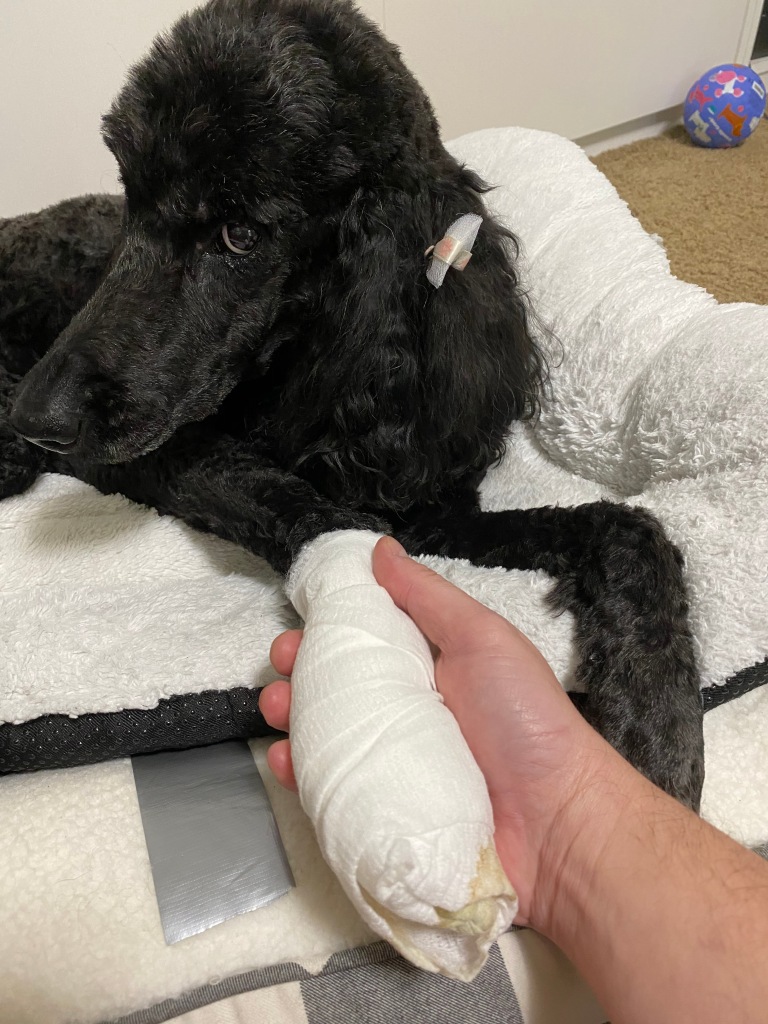I was always a cat person. Had a cat growing up and three since. I’m allergic to cats, but that never stopped me. I’ve always been fascinated by their agility, night vision and independence. Cats are cool. They have superpowers. They poop in sand, automatically. Cats are magic.
I wasn’t sure about dogs. The first time I met Scout, she tried to eat screws, nails, rocks and other random things. She peed and pooped in the house. She would cry uncontrollably if we left her alone. I was worried.

But Scout changed. She learned what I liked and didn’t like. She potty trained in a matter of weeks. She worked tirelessly to understand the inflection in my voice, what spoken commands led to what desired actions, and of course, what led to treats. She changed herself, like she was trying to figure out how to make me happier.
And just like that, every day for the last fourteen years she’s been there, trying to figure out how to make me happy. She’d sleep by my feet when I worked from home in Oregon, keeping my feet warm during the winter. After moving to California, I’d come home from a long day at work and she’d bark and be the first to greet me. She was an outlet — a reason to go hiking in the hills of the Bay Area, go to the park just to watch her run, or just sit down for a minute and exist quietly while scratching her neck. We’d take her to Carmel for poodle day, Oregon during the summer, and many other places. She was our only child for half of her life.

And then there were five
Then she had a sister. When we got Junebug, Scout made room for her new puppy sister, graciously accepting her into the family. We’ve never seen Scout act aggressively toward Junebug, and save or one incident in Carmel when she snapped at a Labrador in a pet shop, she’s been an angel toward other dogs too. She had a good soul; an old soul that has been places.

Then we had Ella, and Scout made room for her. Scout was gracious with the kids. She never resented Ella, and watched her grow up to be a fast-paced 7-year old girl. Early on, Scout was always curious about the baby, but just like Junebug she accepted things as they were. Scout was still happy to see me when I got home, and lived each moment with joy.

As a baby veteran, Scout was not phased at all by Ethan. She accepted him too, but another baby meant fewer walks. She didn’t get out as much, and spent a lot of days hanging out with Junebug. Scout took it all in stride. She still met each day with the same energy, and although she was slowing down, you could always see the puppy in her.
Just to complicate things (we like a challenge), Birdie entered the picture. We got a puppy in the middle of the pandemic, in part, so Scout could get to know her. It’s kind of a work in progress. I think a younger Scout would have loved this puppy, but old Scout doesn’t enjoy being constantly harassed by an ankle biting puppy. The whole scene is pretty hilarious, though.
Time flies
Scout didn’t ever need much. She was an easy puppy, very food driven and empathetic, loyal to the core. She was quick to learn, easy to teach, and remembered. She’s probably the lowest maintenance poodle out there. She didn’t need to be the center of our life.
But I do wish I could go back four or five years and do more with Scout. Life has its moments of triage — you can’t be all things to everyone all the time — and we had to figure out how to manage a new baby while taking care of another kid and two dogs. It meant fewer hikes, fewer trips to the beach, and less 1:1 time with Scout — but to her credit, she never seemed to care. She was always happy with whatever we could give.
A decision
When we took a family trip to Truckee, we noticed Scout’s foot was bleeding. What we thought was a corn had grown to double the size, and had broken skin. When we got home, a biopsy returned positive: she had a malignant tumor in her right front paw.
We decided pretty early on that surgery was not a great idea. At 14, Scout’s regular vet was against surgery due to risks of complication caused by anesthesia. We got a second opinion and even they would have us sign a waver acknowledging the high likelihood of death.
And then, even if Scout recovered, she’d be in severe pain. It would require pain meds that would strain her weakened liver. She’d be immobile for some time, and end up requiring rehab/therapy to learn how to cope with her amputated paw.
Scout could manage her tumor for some period of time, and that was a better alternative to radical surgery like amputation. The tumor is right in her paw pad, which would render most of her foot useless post-surgery. Deciding against surgery was the easy part. It was the right decision.
Ups and downs
All things considered, I’ve really appreciated these last few months. With her tumor growing and pain increasing, I’ve spent more time with Scout. Most nights I sleep with her downstairs in the guest bed, side by side. I change her bandages once a day, and I feed her some yummy canned food (the good stuff) every day. We have some great treats for her — I give her those whenever I change her bandages or give her pain meds.
Scout’s been my co-pilot during stay-in-place. Every day, she’s been chilling with her dad in the office. She’s more comfortable down here, and doesn’t have to go up and down stairs anymore. She sleeps most of the day, and has occasional playful moments, mustering energy to bark at her new baby sister Birdie, and she somehow always has energy to beg for handouts.
As I write this, she is playing with Birdie, seemingly fine w/ her pain meds, and barking loudly at her new sister.

However, in the morning, she will be shaking with pain, and may or may not have pooped a little while sleeping, which she finds really disturbing — she hangs her head in embarrassment when it happens and stands in the corner. Her bandages will need to be changed, and they already smell like death. She is not herself these days more often than not.
Am I a monster for letting her live? Will I be a monster for putting her down in a few days?
While I have cherished these last months, dealing with this duality has been heartbreaking. I’ve cried different kinds of tears.
The end
In four days, we’ll say goodbye.
A vet will come to our house and put Scout to sleep. We’ll all be here with her, she won’t be alone, and she’ll be home — where she’s been for the last ten years.
I made a bucket list for Scout, and she’s pretty much through it. We’re feeding her treats, giving her lots of attention, and we’ll get her some pretty epic meals these last few days.

Her last couple of days will be awesome. We’ll take her for her last walk (not far, given her foot), give her an extra pain pill and let her play fetch in the park, and I’ll cook her some home-cooked doggy stew w/ turkey and vegetables.
This is hard. My heart wants to keep her here, string it out, and hold her against me another time. My brain knows it’s time, and I will have to help her die with dignity while she is still mostly herself. As I write this, she’s putting her head on my leg, worried for me because I’m crying.
In four days, we’ll say goodbye.
The lesson
One of the greatest lessons a pet teaches its owner in life is that it ends. I thought at first that Scout spent most of her life changing herself to make me happy. I learned later that we both changed, and we were both better for it.
And maybe that’s the difference between cats and dogs. Cats are a singularity — some change, some play fetch, but mostly they are who they are and you’re along for the ride. Dogs are something else entirely — they are more malleable, more eager to please, and care enough to change. That level of loyalty, from any corner of our lives, is exceedingly rare.
We don’t always choose when or how we go. In a lot of ways, I feel fortunate. We’re lucky to have this time — we know when her last pet, walk, meal, cuddle or bark might be. There is a somber but free finality in it all.
The lesson, I suppose, is that life is fucking short. We need to have the courage to say goodbye and let go, but mostly, we need to have the courage to love while we still can.

Scout, you were my first dog. Thank you for teaching me about loyalty, responsibility, life and death. I will always love you, and I will miss you so much. Wherever you go next, I hope to find you there.
Also, although it was gross, I forgive you for pooping in the bed.











